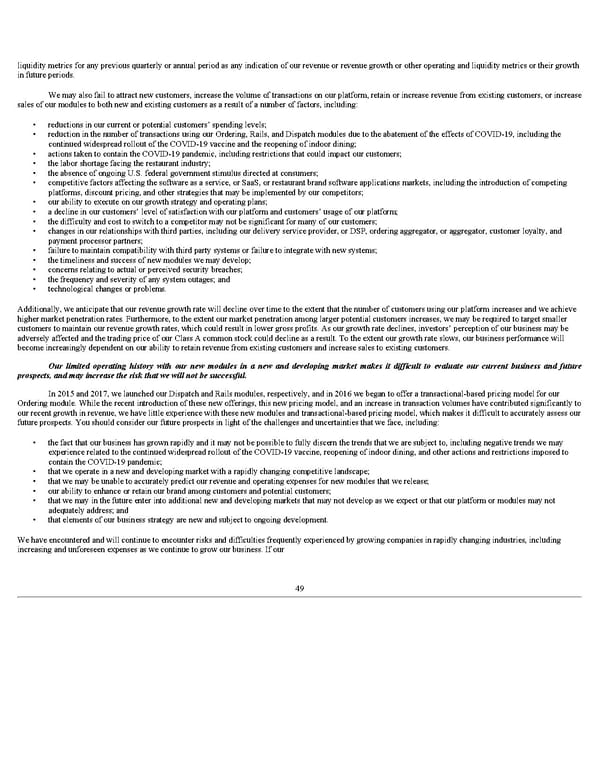liquidity metrics for any previous quarterly or annual period as any indication of our revenue or revenue growth or other operating and liquidity metrics or their growth in future periods. We may also fail to attract new customers, increase the volume of transactions on our platform, retain or increase revenue from existing customers, or increase sales of our modules to both new and existing customers as a result of a number of factors, including: • reductions in our current or potential customers’ spending levels; • reduction in the number of transactions using our Ordering, Rails, and Dispatch modules due to the abatement of the effects of COVID-19, including the continued widespread rollout of the COVID-19 vaccine and the reopening of indoor dining; • actions taken to contain the COVID-19 pandemic, including restrictions that could impact our customers; • the labor shortage facing the restaurant industry; • the absence of ongoing U.S. federal government stimulus directed at consumers; • competitive factors affecting the software as a service, or SaaS, or restaurant brand software applications markets, including the introduction of competing platforms, discount pricing, and other strategies that may be implemented by our competitors; • our ability to execute on our growth strategy and operating plans; • a decline in our customers’ level of satisfaction with our platform and customers’ usage of our platform; • the difficulty and cost to switch to a competitor may not be significant for many of our customers; • changes in our relationships with third parties, including our delivery service provider, or DSP, ordering aggregator, or aggregator, customer loyalty, and payment processor partners; • failure to maintain compatibility with third party systems or failure to integrate with new systems; • the timeliness and success of new modules we may develop; • concerns relating to actual or perceived security breaches; • the frequency and severity of any system outages; and • technological changes or problems. Additionally, we anticipate that our revenue growth rate will decline over time to the extent that the number of customers using our platform increases and we achieve higher market penetration rates. Furthermore, to the extent our market penetration among larger potential customers increases, we may be required to target smaller customers to maintain our revenue growth rates, which could result in lower gross profits. As our growth rate declines, investors’ perception of our business may be adversely affected and the trading price of our Class A common stock could decline as a result. To the extent our growth rate slows, our business performance will become increasingly dependent on our ability to retain revenue from existing customers and increase sales to existing customers. Our limited operating history with our new modules in a new and developing market makes it difficult to evaluate our current business and future prospects, and may increase the risk that we will not be successful. In 2015 and 2017, we launched our Dispatch and Rails modules, respectively, and in 2016 we began to offer a transactional-based pricing model for our Ordering module. While the recent introduction of these new offerings, this new pricing model, and an increase in transaction volumes have contributed significantly to our recent growth in revenue, we have little experience with these new modules and transactional-based pricing model, which makes it difficult to accurately assess our future prospects. You should consider our future prospects in light of the challenges and uncertainties that we face, including: • the fact that our business has grown rapidly and it may not be possible to fully discern the trends that we are subject to, including negative trends we may experience related to the continued widespread rollout of the COVID-19 vaccine, reopening of indoor dining, and other actions and restrictions imposed to contain the COVID-19 pandemic; • that we operate in a new and developing market with a rapidly changing competitive landscape; • that we may be unable to accurately predict our revenue and operating expenses for new modules that we release; • our ability to enhance or retain our brand among customers and potential customers; • that we may in the future enter into additional new and developing markets that may not develop as we expect or that our platform or modules may not adequately address; and • that elements of our business strategy are new and subject to ongoing development. We have encountered and will continue to encounter risks and difficulties frequently experienced by growing companies in rapidly changing industries, including increasing and unforeseen expenses as we continue to grow our business. If our 49
 Q3 2021 10Q Page 54 Page 56
Q3 2021 10Q Page 54 Page 56